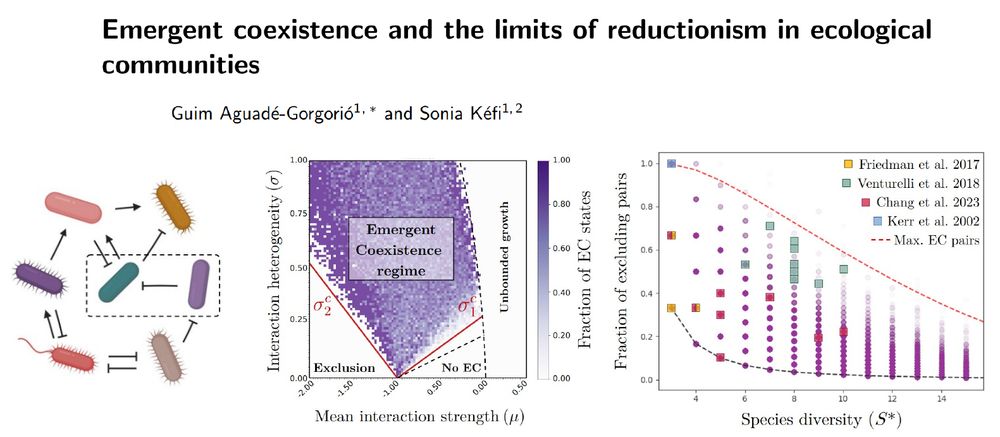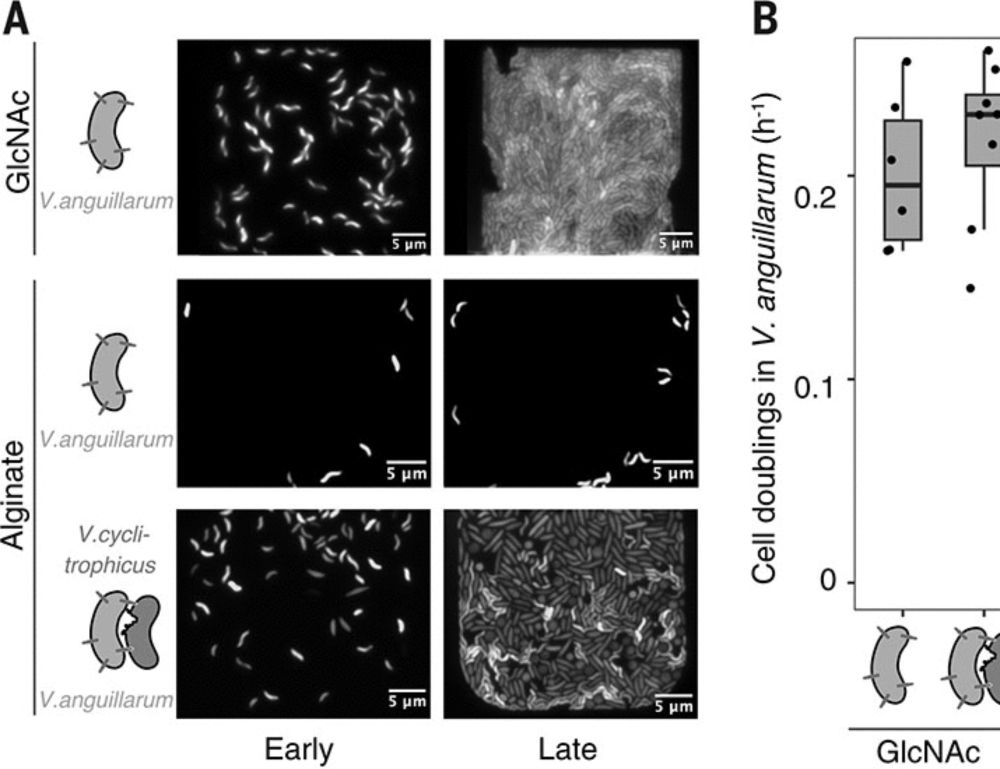

Why fundamental research is fundamental to progress, seeding major breakthroughs
Editorial @nature.com this week
And 7 basic science discoveries that changed the world
nature.com/articles/d41...
nature.com/articles/d41...
@pierremillard.bsky.social
Systems biologist at Toulouse Biotechnology Institute, INRAE, France Member of MetaboHub consortium ❓️ Focus on microbial metabolism for biotechnology and health 🛠 Main tools: modeling, fluxomics, metabolomics, isotope-based approaches


Why fundamental research is fundamental to progress, seeding major breakthroughs
Editorial @nature.com this week
And 7 basic science discoveries that changed the world
nature.com/articles/d41...
nature.com/articles/d41...
Cool enzyme specificity predictor🦠✨! Build on >300k enzyme-substrate pairs (UniProt, BRENDA, literature), combining ESM-2 embeddings and GNNs to model atom–residue interactions. In one test (34 E. coli metabolites × 860 enzymes), it correctly matched 10! #microsky 🧪 www.nature.com/articles/s41...
23.10.2025 09:48 — 👍 16 🔁 2 💬 1 📌 0Domesticated animals have pulled our heavy carts and turned our large mills for centuries. But what about the opposite end of the spectrum—what if the wheel you want to turn is so small you can’t see it?
Turns out we can harness the power of bacteria to power the world’s smallest machines.
1/7 ⚛️🧪

How can we design complex computational systems using synthetic biology? Check our paper, where we use space as a computational element, dramatically reducing communication requirements while allowing modularity, reusability, scalability & minimal cell engineering.
journals.plos.org/ploscompbiol...

Cell-Free-Based Thermophilic Biocatalyst for the Synthesis of Amino Acids from One-Carbon Feedstocks
doi.org/10.1021/acss...

How can biological systems anticipate future events? In our new paper with @jordiplam.bsky.social, we show how a simple genetic circuit can predict future trends through a simple (and perhaps widespread) mechanism @drmichaellevin.bsky.social @koseskalab.bsky.social www.biorxiv.org/content/10.1...
28.04.2025 22:42 — 👍 97 🔁 29 💬 5 📌 3
🚀 Thrilled to share our new Nature Communications article:
“A blueprint for designing the next-generation of synthetic C1 microbes”
We propose a framework to unlock sustainable, carbon-efficient biomanufacturing using non-canonical hosts.
🔗 www.nature.com/articles/s41... A short 🧵1/4

2025 Lasker Awards – “From simplicity to complexity: A path to innovation in science and art.” Read the essay in a PNAS Perspective. Portrait of Joseph L. Goldstein.
For 25 years, the Chair of the @laskerfdn.bsky.social Jury has reflected on the intersection of science and art in an annual essay. This year, Joseph L. Goldstein explores “From simplicity to complexity: A path to innovation in science and art.” Read now: www.pnas.org/doi/10.1073/...
06.10.2025 17:39 — 👍 5 🔁 3 💬 0 📌 0
Image d'un téléphone sur lequel se trouve le logo et le nom de Bluesky. En arrière-plan, un papillon blanc sur fond bleu
Suite à la migration de scientifiques et d'universitaires de X, Bluesky est devenue une l'une des alternatives.
Afin d'évaluer sa viabilité/pertinence pour la communication scientifique, cette étude présente une analyse à grande échelle de la diffusion d'articles scientifiques sur Bluesky.
1/5

Microbial communities can harbor many species that do not coexist in pairs, yet can coexist in the full community. Here we provide the mathematical foundations of emergent coexistence, and explain why it can't be predicted from pairwise tests www.biorxiv.org/content/10.1...
20.05.2025 13:16 — 👍 106 🔁 35 💬 2 📌 1Cool! Some gut microbes make 2-MiCit from propionate. In vitro, it inhibits 3D colon tumor growth (and normal cells at high dose). Just a 'lucky' one among millions of microbial by-products? I haven't thought of any selective advantage 🤔 Thoughts? 🦠🧪 #microsky #microbiomesky doi.org/10.1016/j.ce...
17.09.2025 04:16 — 👍 16 🔁 5 💬 0 📌 0
🥁 Check out our new preprint on OmniPath, the prior knowledge resource for #SystemsBiology, and its brand-new OmniPath Explorer web app! 🥳
📖 Preprint: www.biorxiv.org/content/10.1...
🔍 Explorer: explore.omnipathdb.org
OmniPath integrates 160+ resources for multi-omics analysis & modeling.
🧶⬇️

Thrilled to share our new paper in @science.org describing our discovery that bacteria can switch from competitors to bonafide predators when resources run dry—arming nanoscale “spears” (T6SS) to stab & consume neighbours.
www.science.org/doi/10.1126/...
#MicroSKy #Microbiology
Congrats Snorre!!! 👏 It's great to see this coming out 🎉
and thank you for giving the chance to be a (small) part of this very cool work!
"Microbes release lower-value metabolites at higher rates" 🦠
I've only read the abstract and I already know this paper is so very correct 👀
14.09.2025 03:06 — 👍 73 🔁 22 💬 6 📌 0In our new review, we revisit overflow #metabolism across living organisms and propose universal principles of its functioning, integrating insights from studies on yeast, bacterial, and mammalian cells 🦠✨
First first-author paper of Thomas Gosselin-Monplaisir 🥳
👉 Read it here: urlr.me/82Zspc

Polysomes and mRNA control the biophysical properties of the eukaryotic cytoplasm
07.09.2025 19:50 — 👍 24 🔁 9 💬 0 📌 1A plasmid golden ratio? 🧬
Plasmid copy number ≈ 2.5% of chromosome size—consistent across bacterial species!
pmc.ncbi.nlm.nih.gov/articles/PMC... @jerorb.bsky.social
🧪 #microbesky
Overflow metabolism: Why cells waste nutrients—and why it’s not really waste
go.nature.com/4n39Ijw

Can a single cell learn? Even without a brain, some microbes show simple forms of cognition. Can this basal cognition be engineered? Check our new paper with @jordiplam.bsky.social on the minimal synthetic circuits & their cognitive limits. @drmichaellevin.bsky.social www.biorxiv.org/content/10.1...
10.09.2025 11:48 — 👍 109 🔁 42 💬 4 📌 6
I'm going to be advertising for a few positions in my group in the next couple of months for a big project on synthetic microbial communities.
I would love to hear from you if you are interested and I'd also appreciate if everyone could share this far and wide!

Sub-cellular chemical mapping in bacteria using correlated cryogenic electron and mass spectrometry imaging
Congrats Hannah Ochner and authors on this important paper! Strong collaboration with @kiranrpatil.bsky.social
www.biorxiv.org/cgi/content/...
@mrclmb.bsky.social @wellcometrust.bsky.social
Please repost!
Postdoc in adaptive laboratory evolution and C1 synthetic metabolism!
Location: DTU Biosustain
🦠🧬🔬
Starting in 01/2026!
Fell free to reach out if you have questions!
efzu.fa.em2.oraclecloud.com/hcmUI/Candid...
Je pense à ce fil depuis hier, et je me posais la question de ce que ça implique pour les efforts d'apprendre la programmation et ou l'algorithmique aux non spécialistes.
14.09.2025 08:59 — 👍 2 🔁 2 💬 0 📌 0
Regulation by RNAs might be even more extensive than we thought. Many enzymes and other proteins not previously considered as RNA-binding proteins do seem to fall into this class & might have their activity regulated by RNA.
www.cell.com/cell/fulltex...

Strategies and applications of synthetic cell communication
doi.org/10.1038/s415...

big one! a decade in the making. nadler & team develop tools to track lipid transport in living cells at single-species resolution. turns out non-vesicular, asymmetry-driven transport is the main architect of organelle identity. feels like the dawn of a golden era for lipid biology. rdcu.be/eBGJv
21.08.2025 08:51 — 👍 58 🔁 21 💬 1 📌 0
For life to emerge on Earth, peptides must first have formed without the aid of enzymes — but how? Reactions of sulfur-containing molecules might have been key
go.nature.com/4oX04jC

Aggresomes protect mRNA under stress in Escherichia coli
www.nature.com/articles/s41... "prolonged stress leading to ATP depletion in Escherichia coli results in increased aggresome formation, compaction and selective mRNA enrichment within these aggresomes" 🦠 #microsky #rnasky

Autocatalytic selection of gene functions in vitro
doi.org/10.1101/2025...